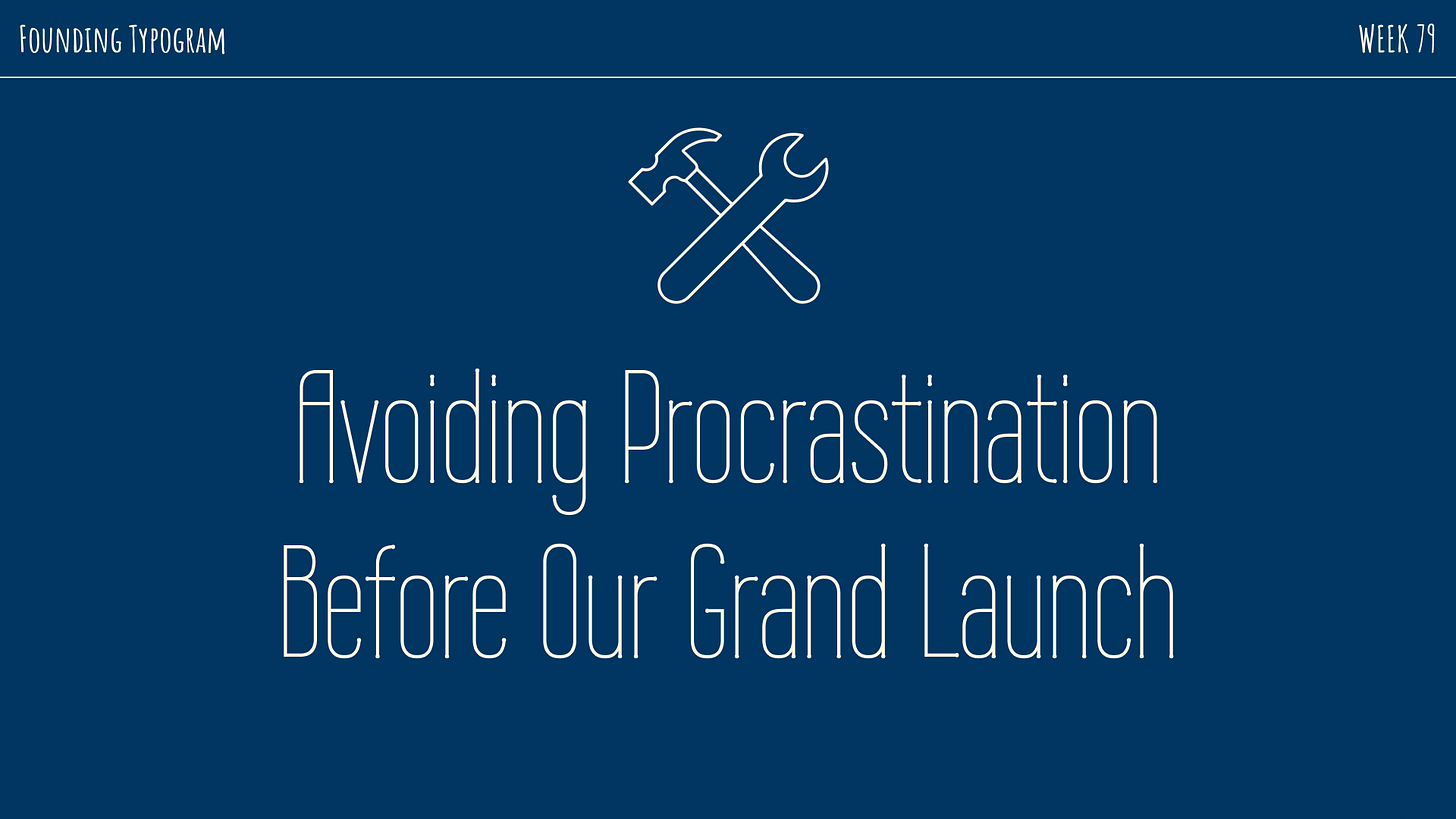Avoiding Procrastination Before Our Grand Launch
Week 79 of Founding Typogram
Do you have a friend who enjoy reading about startup and build in public? If so, please share my newsletter with them!
Hi friends, a few months ago, I shared what I did to get through stressful times. Since the last few weeks, My co-founder and I have been working intensely toward the grand launch later this month. So for this week, I want to share more personal experiences and techniques on another nemesis of mine: Procrastination.
When I first started working on my startup, I loved the idea of being fully in charge of my schedule. Soon, it dawned on me that I would be 100% responsible for my time, task, and productivity. Other than my co-founder, completing everything and meeting milestones are 100% my responsibility. I procrastinate due to stress and anxiety with deadlines. As I’m inching closer to a grand launch for Typogram, I’m trying extra hard to avoid procrastination.
If you are like me, here are a few tips I’m using to avoid procrastination.
Pomodoro Technique
I discovered the Pomodoro Technique when I was a graduate student in art school and doing my thesis. The Pomodoro Technique is a time management method based on 25-minute stretches of focused work sessions, with 5-minute break sessions.
When I have trouble getting into the work zone, I use the Pomodoro Technique in a way that helps me get into the flow. As part of my work routine, I usually start writing down my to-dos the night before and start my Pomodoro sessions the next day. A very effective strategy is starting the work session by debugging a minor bug – a quick-to-fix issue.
Solving a small problem like this gets me into the coding workflow and provides enough “inertia” for me to continue doing other tasks. I will keep working without the 5-minute breaks if I get into a deep flow state. Sometimes, the 5-minute break sessions don’t work for the type of person I am and are disruptive to my workflow. It is not strictly Pomodoro technique without the 5mins break, but this way of using Pomodoro helps me. You can use the technique in whichever way as long as it works for you!
Additional Strategies that Help Me
Touch it once
“Touch it Once” is the philosophy that you complete the task as soon as you touch it the first time, and avoid “touching it twice” which means you schedule it to be completed at later times.
The “Touch it once” philosophy helps me with smaller and trivial tasks tremendously, especially with things like emails or Slack messages. Once I open, aka. “touch” an email or Slack message, I respond right away. If I receive the email at odd hours, I draft the answer right away and then schedule the send.
Don’t waste time and energy touching the same material twice — taking email as an example, touching it twice would mean you have to read and think about it twice. “Touch it once” helps reduce the time required for finishing these tasks. It also helps me to be a more responsive communicator, and I get compliments on this all the time. It shouldn’t be a surprise that people are generally very delighted to get a response within 5 mins after they send it. It takes no extra effort on my part — I just happen to be on my phone when I got the notification.
Not committing code at the end of the day
This one may be controversial: after a long day of coding, I would leave the last batch of code edits uncommitted and finish it up the next day.
After I commit code, it feels like a clean state, and there is no immediate action to take afterward. It takes me longer to get back into the coding the next day. Not committing the code allows me to look at uncommitted changes very easily (in VS Code) and that gives me a quick reminder of what I was working on.
The uncommitted code is either not finished, which I can pick up the rest of the task right away; or it is ready to commit, which I can take a quick win right off the bat the next morning by committing them. Either way, I am back into the coding flow much faster.
Hear from you
What’s your routine to avoid procrastination?
❧
See you next week! If you have friends who are interested in founding start-ups, please consider sharing my newsletter with them!




Big thumbs-up for pomodoros! I wrote one with my first grand daughter in Scratch (yes, I was procrastinating) years ago and I still use that one today.
I commit when the thought of the code is complete. I agree that coming back to it uncommitted is easier because the code is still in my head - I don't understand how that works.
Answering email is a trap for me so I do clean up in the morning and come back to it as I can. Some emails take an awful long time to answer. :)
Thanks for writing,
Chris C